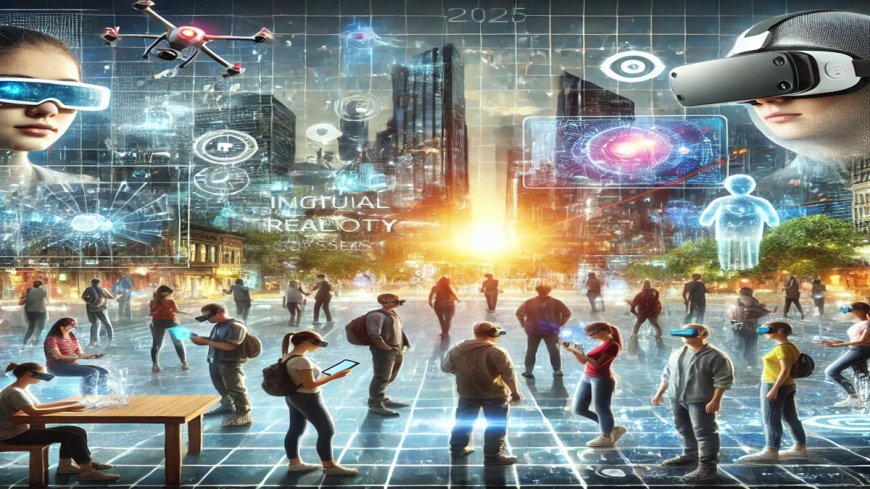What is Immersive Technology? A Comprehensive Guide to Immersive Technology 2025
Discover the transformative potential of Immersive Technology 2025. Learn how AR, VR, and MR are revolutionizing industries and shaping the future of technology.

Immersive technology refers to the suite of technologies that create a simulated or enhanced reality by engaging one or more of the human senses. These technologies enable users to interact with digital environments in ways that feel natural and intuitive, often blurring the line between the physical and virtual worlds. As we approach 2025, immersive technology 2025 is poised to revolutionize industries such as education, healthcare, entertainment, retail, and more.
The Core Components of Immersive Technology
- Virtual Reality (VR): VR immerses users in entirely digital environments, often requiring specialized headsets like the Oculus Quest or HTC Vive. It’s widely used in gaming, training simulations, and virtual tours.
- Augmented Reality (AR): AR overlays digital elements onto the physical world. Think of applications like Pokémon GO or AR filters on social media. Devices such as smartphones, tablets, and AR glasses enable AR experiences.
- Mixed Reality (MR): Combining elements of VR and AR, MR allows real and virtual objects to interact seamlessly. For example, Microsoft’s HoloLens is a popular MR device.
- Extended Reality (XR): XR is an umbrella term that encompasses VR, AR, and MR, signifying any form of immersive technology that extends or modifies reality.
- 360-Degree Content: This involves panoramic images or videos that allow users to explore a scene from all angles. Commonly used in virtual tours and real estate.
Why Immersive Technology Matters in 2025
The year 2025 is expected to mark a significant milestone for immersive technology, driven by advancements in hardware, software, and connectivity. Here’s why it’s gaining momentum:
- Enhanced Hardware: Lightweight, affordable headsets and AR glasses are making immersive experiences more accessible.
- 5G Connectivity: Faster internet speeds and lower latency enable seamless streaming of high-quality immersive content.
- AI Integration: Artificial intelligence enhances the realism of simulations, making them more responsive and interactive.
- Increased Adoption: Businesses and educational institutions are increasingly leveraging immersive technology for training, marketing, and engagement.
Applications of Immersive Technology in 2025
- Education: Immersive classrooms powered by VR and AR offer students engaging ways to learn complex subjects, from history to medical procedures.
- Healthcare: Surgeons can practice in VR environments, while AR aids in diagnostics and minimally invasive procedures.
- Entertainment: The gaming and film industries are adopting VR and AR to deliver highly engaging experiences.
- Retail: Virtual try-ons and immersive shopping experiences are transforming the way consumers interact with brands.
- Remote Work: Virtual offices and AR collaboration tools are bridging the gap for distributed teams.
Benefits of Immersive Technology
- Enhanced User Engagement: Immersive experiences capture attention and improve memory retention.
- Cost-Effective Solutions: Training and prototyping in virtual environments reduce expenses and risks.
- Accessibility: Immersive tools make specialized knowledge and experiences more widely available.
Challenges of Immersive Technology
While the future looks promising, several hurdles must be overcome:
- High Development Costs: Creating immersive experiences can be expensive.
- Privacy Concerns: The data collected by immersive devices raises security issues.
- User Fatigue: Prolonged use of immersive technologies may lead to discomfort.
Immersive Technology 2025: What’s Next?
The immersive technology landscape is evolving rapidly. By 2025, we can expect:
- Better Accessibility: Affordable devices will make these technologies more mainstream.
- Seamless Integration: Immersive tools will become a natural part of daily life and work.
- Advanced Applications: From smart cities to personalized healthcare, the possibilities are limitless.
How to Prepare for Immersive Technology 2025
- Stay Updated: Follow industry trends and updates to understand the latest advancements.
- Upskill: Learn skills like 3D modeling, AR development, or immersive content creation.
Adopt Early: Businesses should consider pilot projects to test the feasibility of immersive solutions.
Conclusion
Immersive technology is reshaping the way we interact with the world, offering endless possibilities across industries. As we move toward 2025, the integration of VR, AR, and MR into daily life will become increasingly seamless. By staying informed, upskilling, and adopting these technologies early, individuals and organizations can unlock their full potential. The future of immersive technology is bright, and it’s time to embrace the transformation.
Content Source - https://medium.com/@priyankapandey08/what-is-immersive-technology-a-comprehensive-guide-to-immersive-technology-2025-eefa55b8f22a
What's Your Reaction?

























